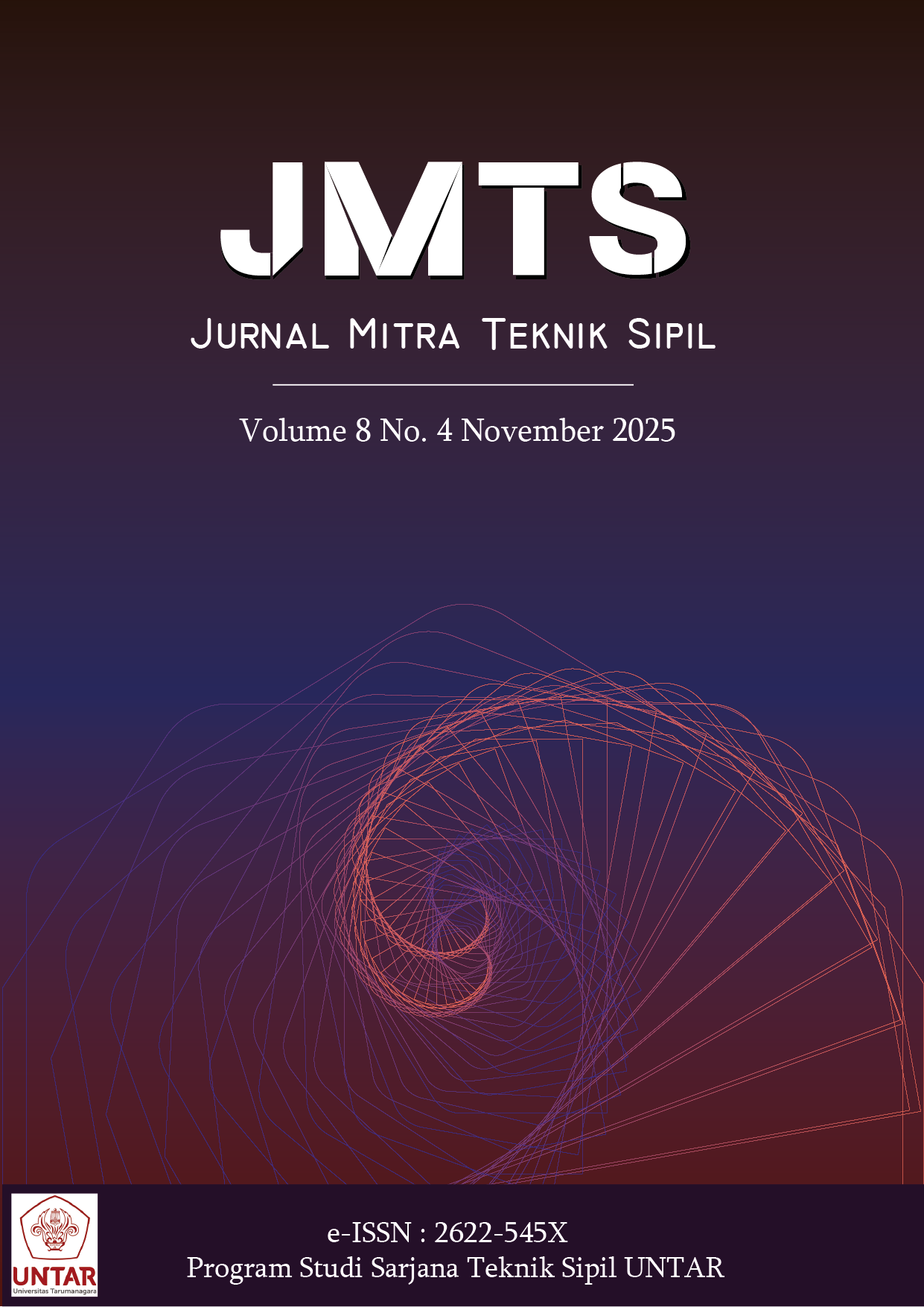PERAN FLUID VISCOUS DAMPER (FVD) DALAM MEREDUKSI RESPON DAN MENINGKATKAN KINERJA STRUKTUR BANGUNAN AKIBAT AKTIVITAS SEISMIK
Main Article Content
Abstract
Large earthquakes can cause structural damage to civil buildings and endanger the safety of human life, so an effective mitigation system is needed. Fluid viscous damper (FVD) is one of the innovative solutions in reducing earthquake energy entering the structure. This research examines the effectiveness of FVD in reducing the response and improving the performance of building structures. The object of study is the Santika Pasir Koja Hotel building, Bandung. The analysis was conducted using numerical modeling in ETABS v22.1 with two scenarios: (1) without FVD and (2) with FVD. The parameters evaluated include floor displacement response, level shear force, base shear, structural frequency/period and structural performance level of the building based on ATC-40 and FEMA- 451. The analysis showed that FVD was able to reduce the drift by (26-62)%. The average reduction of level shear force is 39.8%, and the reduction of base shear during the plan earthquake load is 33.35%. In terms of performance, the structure with FVD reached the “Life Safety (LS)” performance level, while without FVD it was at the “Collapse Prevention (CP)” performance level. Thus, the implementation of FVD is recommended for high-rise buildings in earthquake-prone areas. Further research is recommended to optimize the damping parameters and distribution of FVD damping coefficients on more complex structures.
Abstrak
Gempa bumi yang besar dapat menyebabkan kerusakan struktural bangunan sipil dan membahayakan keselamatan jiwa manusia sehingga diperlukan sistem mitigasi yang efektif. Fluid Viscous Damper (FVD) merupakan salah satu solusi inovatif dalam meredam energi gempa yang masuk kedalam struktur. Penelitian ini mengkaji efektivitas FVD dalam mengurangi respon dan meningkatkan kinerja struktur bangunan Gedung. Objek kajian adalah gedung Hotel Santika Pasir Koja, Bandung. Analisis dilakukan menggunakan pemodelan numerik di ETABS v22.1 dengan dua skenario : (1) tanpa FVD dan (2) dengan FVD. Parameter yang dievaluasi meliputi respon perpindahan lantai, gaya geser tingkat, gaya geser dasar, frekwensi/periode struktur dan tingkat kinerja struktur yang didasarkan ATC-40 dan FEMA - 451. Hasil analisis menunjukkan bahwa FVD mampu mengurangi drif sebesar (26 -62)%. Rata-rata reduksi gaya geser tingkat sebesar 39,8 %, dan reduksi gaya geser dasar saat beban gempa rencana sebesar 33,35%. Dari aspek kinerja, struktur dengan FVD mencapai level kinerja "Life Safety (LS)", sedangkan tanpa FVD berada pada level kinerja "Collapse Prevention (CP)". Dengan demikian, implementasi FVD direkomendasikan untuk bangunan bertingkat di daerah rawan gempa. Penelitian lebih lanjut disarankan untuk mengoptimalkan parameter peredam dan distribusi koefisien peredam FVD pada struktur yang lebih kompleks.
Article Details

This work is licensed under a Creative Commons Attribution-NonCommercial-ShareAlike 4.0 International License.
This work is licensed under Jurnal Mitra Teknik Sipil (JMTS) Creative Commons Attribution-ShareAlike 4.0 International License.References
ATC-40. (1996). Seismic evaluation and retrofit of concrete buildings. Applied Technology Council.
Badan Standardisasi Nasional. (2019). Persyaratan beton struktural untuk bangunan gedung (SNI 2847:2019). http://sispk.bsn.go.id/SNI/DaftarList
Badan Standardisasi Nasional. (2019). Tata cara perencanaan ketahanan gempa untuk struktur bangunan gedung dan non gedung (SNI 1726:2019). http://sispk.bsn.go.id/SNI/DaftarList
Badan Standardisasi Nasional. (2020). Beban minimum untuk perancangan bangunan gedung dan struktur lain (SNI 1727:2020). http://sispk.bsn.go.id/SNI/DaftarList
Elwardany, H., Jankowski, R., & Seleemah, A. (2021). Mitigating the seismic pounding of multi-story buildings in series using linear and nonlinear fluid viscous dampers. Archives of Civil and Mechanical Engineering, 21(4), 1–16. https://doi.org/10.1007/s43452-021-00249-9
FEMA 451. (2006). NEHRP recommended provisions: Design examples. Federal Emergency Management Agency.
Guo, Y., Wang, S., & Zhang, S. (2024). Seismic performance of building structures based on improved viscous damper seismic design. Journal of Vibroengineering, 26(5), 1082–1100. https://doi.org/10.21595/jve.2024.23988
Praja, B. A., & Avanti, J. B. (2022). Waktu getar struktur bangunan gedung dengan peredam getar eksternal fluid viscous damper. Journal of Civil Engineering, Building and Transportation (JCEBT), 6(2), 117–123. http://ojs.uma.ac.id/index.php/jcebt
Pribadi, A., Desmaliana, E., & Fadlisha, D. T. (2020). Studi perbandingan respon struktur gedung menggunakan fluid viscous damper dengan variasi jumlah lantai. RekaRacana: Jurnal Teknik Sipil, 6(1), 22–32. https://doi.org/10.26760/rekaracana.v6i1.22
Ras, A., & Boumechra, N. (2016). Seismic energy dissipation study of linear fluid viscous dampers in steel structure design. Alexandria Engineering Journal, 55(3), 2821–2832. https://doi.org/10.1016/j.aej.2016.07.012
Scholl, R. E., & Miyamoto, H. K. (1998). Seismic response modification factor for fluid viscous dampers. Proceedings of the Structural Engineers Association of California.
Şigaher, A. N., & Constantinou, M. C. (2003). Scissor-jack-damper energy dissipation system. Earthquake Spectra, 19(1), 133–158. https://doi.org/10.1193/1.1540999
Takewaki, I. (2009). Building control with passive dampers: Optimal performance-based design for earthquakes. Wiley. https://doi.org/10.1002/9780470824931
Taylor, D. P. (2007). Fluid viscous dampers for seismic applications: The state of the art. Journal of Structural Engineering, 133(1), 1–15. https://doi.org/10.1061/(ASCE)0733-9445(2007)133:1(1)
Trivedi, A., Shrivastava, G., & Patil, K. (2023). Seismic analysis of irregular diaphragm reinforced concrete building with fluid viscous dampers. International Journal for Research in Applied Science and Engineering Technology, 11(6), 1620–1626. https://doi.org/10.22214/ijraset.2023.55029
Uang, C. M., & Bertero, V. V. (1988). Evaluation of seismic energy in structures. Earthquake Engineering and Structural Dynamics, 16(3), 439–456. https://doi.org/10.1002/eqe.4290160310



